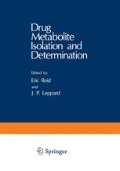Abstract
Carbon monoxide has now been identified as a metabolite of a number of foreign compounds, including tetrahalogenomethanes [1]3 trihalogenomethanes [2], trichloroethylene [3] and methylenedioxyphenyl compounds [5]. It is produced as a result of interactions with cytochrome P-450 of the microsomal monooxygenase enzyme system of liver. In several instances, and particularly with CCl4, the metabolic inactivation by cytochrome P-450 results in loss of haem and initiation of lipid peroxidative damage of the microsomal membranes. Both haem degradation and lipid peroxidation are possible sources of CO, and consequently there is an analytical problem in distinguishing between CO produced as a metabolite of the foreign compound and that which arises from degradation of the biological components.
Access this chapter
Tax calculation will be finalised at checkout
Purchases are for personal use only
References
Wolf, C.R., Mansuy, D., Nastainczyk, V., Deatchmann, G. & Ullrich, V. (1977)Mol. Pharmacol. 13, 698–705.
Ahmed, A.E., Kubic, V.L. & Anders, M.W. (1977) Drug Metab. Dispos. 5, 198–204.
Kubic, V.L. & Anders, M.W. (1975) Drug Metab. Dispos. 3, 104–112.
Traylor, P.S., Nastainczyk, W. & Ullrich, V. (1977) in Microsomes and Drug Oxidations (Ullrich, V., et al., eds.) , Pergamon, Oxford, pp. 104–112.
Yu, L.S., Wilkinson, C.F. & Anders, M.W. (1980) Biochem. Pharmacol. 29, 1111–1122.
Ahr, H., King, L.J., Nastainczyk, W. & Albrich, V. (1980) Biochem. Pharmacol. 23, 2855–2861.
Author information
Authors and Affiliations
Editor information
Editors and Affiliations
Rights and permissions
Copyright information
© 1983 Plenum Press, New York
About this chapter
Cite this chapter
King, L.J. (1983). A Note on Discrimination Between Carbon Monoxide as a Metabolite of Carbon Tetrachloride and as a Degradation Product of the Biological Material. In: Reid, E., Leppard, J.P. (eds) Drug Metabolite Isolation and Determination. Methodological Surveys in Biochemistry and Analysis, vol 12. Springer, Boston, MA. https://doi.org/10.1007/978-1-4684-4484-1_30
Download citation
DOI: https://doi.org/10.1007/978-1-4684-4484-1_30
Publisher Name: Springer, Boston, MA
Print ISBN: 978-1-4684-4486-5
Online ISBN: 978-1-4684-4484-1
eBook Packages: Springer Book Archive

